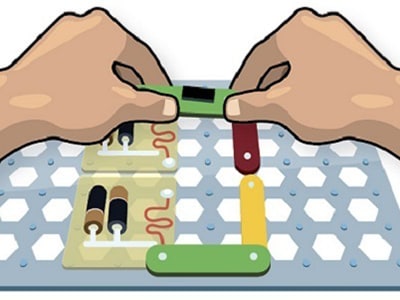In our first Back to Basics blog “What is Instructional Design?” we talked about the concept and definition of instructional design. This week, we wanted to cover some common terms that you are bound to hear in almost instructional design setting.
This list isn’t meant to be all inclusive, but it’s a great starting point to give you the initial vocabulary you need. For the experienced Instructional Designers out there, what terminology did you wish you had known first?
ADDIE
A conceptual and iterative application model for instructional systems design; the components include: Analysis, Design, Development, Implementation, and Evaluation.
Analysis
First phase of ADDIE. Aims at identifying probable causes for the absence of performance and recommends a solution. Includes user/audience analysis, context analysis, and task analysis.
Behavior
Action that is an overt, observable, measurable performance.
Blended Learning
Also referred to as hybrid learning. Learning and instructional techniques that integrate e-learning (such as podcasts and online discussion) mobile learning (such as just-in-time training and performance support) and instructor-led training (such as lectures and tutorials).
Cognitive Strategies
Specific methods used to solve problems, including reasoning, planning, rehearsal of newly learned information, and relating newly-learned information to existing knowledge. An important cognitive strategy for learning is metacognition (or “knowing about knowing”), which is consciously using particular strategies for learning or problem solving.
Condition
Component of a learning objective that describes the specific situation in which the performance occurs.
Deliverables
Measurable, tangible, verifiable output that must be produced to complete the project or a training course. Deliverables could include design documents, alpha/beta/final versions of eLearning modules, and instructor/student guides.
Delivery System
The method by which instruction is provided to learners, for example instructor-led, distance learning, computer-based, web-based, mobile, or self-instructional materials.
Design
The second phase of the ADDIE instructional systems design process; its purpose is to verify the learning tasks, performance objectives, and testing strategies.
Design Document
The document completed at the conclusion of the Design phase showing a detailed overview of the training. Components included are: a sequenced list of learning tasks; a sequenced list of performance (learning) objectives; a list of testing strategies, a summary of benefits derived from the training.
Development
The third phase of the ADDIE instructional systems design process; its purpose is to develop and validate the training materials.
Distance Learning and Distance Education
Education that occurs when students and instructors not in the same location. There is often a geographic and time separation.
E-Learning (Electronic Learning)
Learning facilitated and supported through the use of information and communications technology. E-learning is typically delivered via the Internet using such technologies as self-paced courses, teleconferencing, and video conferencing.
Evaluation
The fifth phase of the ADDIE instructional systems design process; its purpose is to assess the quality of the training materials prior to and after implementation and the ISD procedures used to generate the instructional products. Includes both Formative and Summative Evaluation.
Feedback
Information given to the learner that either confirms a response or provides correction or remediation.
Field Trial
The third stage in formative evaluation, referring to the evaluation of the program or product in the setting in which it is intended to be used. Also, the second phase of summative evaluation.
Flowcharting
Procedure for identifying and graphically representing the sequential and alternative relationships among processes and decision points relevant to completing a project.
Formative Evaluation
Iterative testing during the Development to ensure training meets intended goals.
Group-based Instruction
The use of learning activities and materials designed to be used in a collective fashion with a group of learners in interactive, group-paced instruction.
Hierarchical Analysis
A technique used with goals in the intellectual skills domain to identify the critical subordinate skills needed to achieve the goal, and their interrelationships. For each subordinate skill in the analysis, this involves asking, What must the student know how to do in order to learn the specific subskills being considered?
ID Model
A graphic representation of a systematic approach. Designed to facilitate efficient and effective development of instruction.
Implementation
The fourth phase of the ADDIE instructional systems design process. In this phase, learning is delivered – in the case of eLearning, deployed on the Learning Management System and taken by learners; in the case of Instructor-Led Training, the course is taught to learners.
Individualized Instruction
The use, by students, of systematically designed learning activities and materials specifically chosen to suit their individual interests, abilities, and experience. Such instruction is usually self-paced.
Instruction
Instruction is the delivery of information and activities that facilitate learner’s attainment of intended learning goals.
Instructional Analysis (Content Analysis)
Process of identifying the relevant knowledge, skills, and abilities required for a learner to achieve a behavioral goal. In this process, an instructional goal or a learning task is divided into the steps/elements and skill objectives to achieve the goal. Instructional analysis provides data for developing the Design Document.
Instructional Goals
Brief statements describing the terminal tasks learners will be able to perform as a result of the training.
Instructional Strategies
Means that enable learners to master course content and skills. Examples include: demonstrations, role plays, hands-on activities, practice, simulations, discussion, lecture, illustrated diagrams, step-by-step review; self-study exercises, reviews, on-the-job training, practice with coaching, video demonstrations, examples, etc. Often organized by these categories: pre-instructional activities, content presentations, learner practice, feedback, and closure.
Instructional Systems Design (Instructional Design)
The name given to the process of creating instruction in order to close a performance gap that is due to a lack of knowledge and skills.
Instructor Guide (Facilitator Guide)
The resource that is used by the facilitator to lead the instruction; can be either printed or electronic, such as PDF. Incorporates all aspects of analysis and design into its development, making it the primary vehicle to house all facets of the instruction: instructional strategies, testing strategies, learning objectives, content, pacing, timing, introductions, closure, transitions, and reviews.
Job Aids
Teaching devices intended to be self-explanatory and self-instructional; a formalized set of textual and/or graphical step-by-step directions for accomplishing a task through one or more techniques. Job aids are often designed to be used on the job following training.
Learner Analysis
Data collected about learner group that is used to impact decisions throughout the instructional process. Components include learner group identification, general characteristics, numbers, and location, experience level, attitude, and skills that impact the design and delivery of training.
Learner Guide
Resource used in the instructional process to enhance the learning during the training and, in some situations, to use as a reference tool following training.
Learning Context
The circumstances that are necessary for learning. The learning context must be taken into account for meaningful learning to occur.
Learning Management System (LMS)
Software (web) application used to plan, implement, and assess learning processes. An LMS provides instructors with a way to create and deliver content, monitor learner participation, and assess performance. An LMS provide interactive features such as threaded discussions, video conferencing, and discussion forums, etc.
Media
Physical means selected or developed to communicate instructional messages. Examples include drawings, presentation, video, computer, tablet, model, etc.
Mobile Learning
Learning that is delivered using mobile communication technologies, such as tablets, smartphones, and similar devices. Mobile learning can includes performance support systems, brief tutorials, checklists, and videos.
Module
Instructional package with a single integrated theme that provides the information needed to develop mastery of specified knowledge and skills, and serves as one component of a total course or curriculum.
Needs Assessment
Tool used to identify “the gap” between what is already known and what needs to be learned in order to address particular organizational or personal needs. Needs assessment uses questionnaires, surveys, interviews, observation, etc to collect data.
Objectives (Learning)
The desired outcomes for the training event (what the training should accomplish in terms of performance the learners should exhibit in the learning environment in order to be considered competent); consist of three components (the performance, criterion and standard); are congruent with the tasks and testing strategies. (Objectives can also be established for on-the-job performance, business or impact performance, or ROI).
Objectives (Performance)
Describes what the learner should be able to do on-the-job (as opposed to what the learner should be able to do within the learning environment as a result of the training). Detailed description of what students will be able to do when they complete a unit of instruction.
Also known as behavioral objective or instructional objective. Criteria for assessing the performance – Audience Behavior, Condition, Degree (ABCD).
Online Learning
A term used to describe distance learning conducted via the Internet.
Performance Discrepancy (Performance Gap)
Gap that exists between the Actual Performance (the current performance of learner) and the Desired Performance (required or requested performance).
Pilot Test
The last step in the Field Trial (the third phase of formative evaluation). Data collected is provided to the client who uses it to make the final decision about whether to proceed with implementation.
Post-test
A criterion-referenced test designed to measure performance of objectives to be taught during a unit of instruction; given after the instruction.
Pre-test
A criterion-referenced test designed to measure performance of objectives to be taught during a unit of instruction and/or performance on entry behaviors; given before instruction begins.
Prototype
A functional version of a new process and/or product, usually in an unfinished state, whose effectiveness and efficiency to be tested.
SCORM
Stands for Sharable Content Object Reference Model. Collection of specifications that enable interoperability, accessibility, and reusability of e-learning content.
The SCORM standard is used to facilitate the interaction of eLearning modules with a Learning Management System to record data such as course completion and assessment scores.
Storyboarding
A design technique for showing as individual scenes the proposed sequence of visual, textual, and audio elements in a learning module (such as a video or eLearning module)
Subject Matter Expert (SME)
Person responsible for the accuracy of facts, concepts, and other instructional content.
Summative Evaluation
Testing done following the Implementation phase (including pilot testing and subsequent Kirkpatrick’s Levels of Evaluation).
Task Analysis
Process of identifying, sequencing, and relating the tasks and subtasks that should be performed in order to meet learning objectives. Driving force in performance technology and instructional systems development.
Test Criteria
Test criteria are the component of a learning objective that describes the quality or standard of performance that will be considered acceptable.
Trainer (Facilitator or Instructor)
This is the person who will be presenting the portions of the training that require lecture, facilitation, or other types of live coordination.
Web-based Training (WBT)
Instructional or training technique, which utilizes the Web environment.







